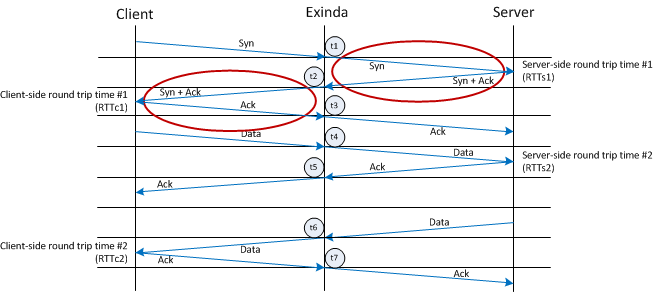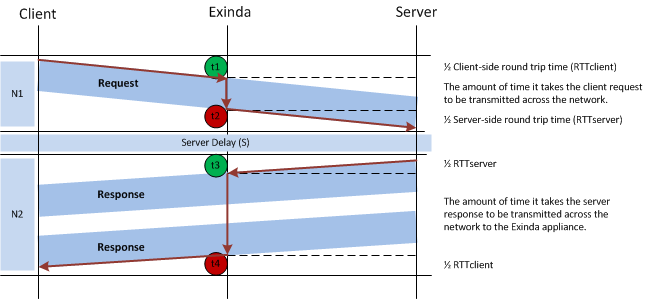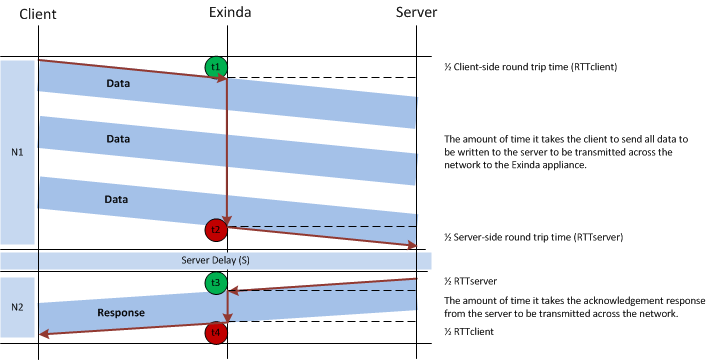Round Trip Time (RTT) & Other Metrics - Apt3kStudio/Phone GitHub Wiki
Calculating Network Performance Metrics
A transaction is defined as a client request followed by a server reply, including both TCP and UDP flows. With each read and write transaction between a client and a server, the following values are measured and used to calculate how long the transaction takes to complete:
- Round Trip Time — the time taken for a very small packet to travel across the network and return
- Network Delay— the overall time taken for data to cross from a client to a server, or from the server to a client.
- Server Delay— the time taken for a server to respond to a request.
- Total Transaction Delay— The time taken for data to cross the network from a client to the server and back. Unlike round trip time, this could include large packets and could result in multiple packets being sent to the server, or received from the server.
- Network Jitter— measures the variability of the network delay time. This is expressed as a multiple of one standard deviation.
- Packet Loss— measures when one or more packets within a transmission are successfully sent, but fail to arrive at the destination.
Calculating RTT
Round Trip Time (RTT) is the measure of how long it takes for a very small packet to travel across the network and for an acknowledgment of that packet to be returned.
Consider the typical topology where an Exinda appliance is positioned between the client and the server.
As each packet is intercepted by the Exinda appliance, it is time stamped with a highly accurate nanosecond resolution clock source. Since the Exinda appliance intercepts the packet after the client sends the packet, the start time is not known and so the RTT is determined by summing the round trip time from the appliance to the server and back (Server RTT), and the round trip time from the appliance to the client and back (Client RTT). As more packets are sent from the client through the Exinda appliance make the round trip, the RTT estimate is updated by averaging new information.
The following diagram illustrates how the round trip time is calculated:

Server RTT:
- RTTs1 = t2 - t1
- RTTs2 = t5 - t4
Client RTT:
- RTTc1 = t3 - t2
- RTTc2 = t7 - t6
Average RTT:
- Average Server RTT = (RTTs1 + RTTs2)/2
- Average Client RTT = (RTTc1 + RTTc2)/2
- Average Total RTT = avRTTs + avRTTc
Normalizing Transaction Delay Metrics
To create accurate comparisons of the network delay experienced by a transaction, the appliance must analyze packets of the same size (normalized). All other factors being equal, the transaction delays should increase with the amount of data transferred or the transaction size.
To make the Application Performance Score (APS) independent of transaction size, the transaction delay metrics are normalized using a constant of 1024 bytes. The normalized network delay is calculated as follows:
Normalized Network Delay = Total Network delay * 1024 / transaction bytes
NOTE
Due to the nature of normalization, protocols that naturally use very small sized packets (like RDP and Citrix) will produce APM values higher than the real ones given such that the results are being multiplied by 1024. The number of bytes used to normalize the calculation of the network delay during a transaction can be configured through the Command Line Interface (CLI), as well as disabling normalization altogether. For more information refer to CLI: APM.
Calculating Network And Server Delay In A Read Transaction
When a client computer requests information from the server, the request and response are tracked to determine how long it takes for the client to send the request, and the server to send the requested data back to the client. The diagram below shows the flow (the network traffic between network objects) of information between the client, the Exinda appliance, and the server, and identifies the points in the transaction where time stamps are acquired.

A visual presentation of a network read transaction
Network Delay for Read Request (N1)
- The client sends a request to the server.
- When the request passes through the Exinda, the time stamp is noted as the beginning of the request (t1).
- When the end of the request passes through the Exinda, the time stamp is noted (t2). t2 - t1 = The amount of time it takes the client request to pass through the Exinda appliance. The server receives the complete client request.
Server Delay for Read Request (S)
- After the server receives a request from the client, the server takes some time to process the request. This is the Server delay (S).
Network Delay for Read Response (N2)
- The server’s response to the client request is sent, and may be sent in a number of packets.
- When the first response passes through the Exinda, the time stamp is noted (t3).
- When the end of the last response passes through the Exinda, the time stamp is noted (t4). t4 – t3 = The amount of time it takes the data requested by the client to pass through the Exinda appliance.
- The client receives the data requested from the server.
Total Time for Read Transaction
The total transaction time for a Read transaction is calculated as Transaction time = N1 + S + N2 where:
- N1 = ½ RTTclient + (t2 – t1) + ½ RTTserver
- S = (t3 – t2) – RTTserver
- N2 = ½ RTTserver + (t4 – t3) + ½ RTTclient
Calculating Network And Server Delay In A Write Transaction
When a client computer sends information to be written to the server, the request and response are tracked to determine how long it takes for the client to send the data to the server, and the server to send an acknowledgment of receiving the data back to the client. The diagram below shows the flow (the network traffic between network objects) of information between the client, the Exinda appliance, and the server, and identifies the points in the transaction where time stamps are acquired.

A visual representation of a network write transaction
Network Delay for Write Request (N1)
- The client sends data to be written on the server, and may be sent in a number of packets.
- When the first data packet starts passing through the Exinda, the time stamp is noted as the beginning of the packet (t1).
- When the end of the last data packet passes through the Exinda, the time stamp is noted (t2).t2 – t1 = The amount of time it takes the client to send data through the Exinda appliance.
- The server receives all the data from the client.
Server Delay for Write Request (S)
- There is a very small delay between receiving the data from the client and the acknowledgement that is sent from the Server back to the client. This is the Server delay (S).
Network Delay for Write Response (N2)
- The server’s acknowledgment response to the client that the data has been received is sent.
- When the response passes through the Exinda, the time stamp is noted (t3).
- When the end of the response passes through the Exinda, the time stamp is noted (t4). t4 – t3 = The amount of time it takes the server response to pass through the Exinda appliance.
- The client receives the response from the server.
Total Time for Write Transaction
The total transaction time for a Write transaction is calculated as Transaction time = N1 + S + N2 where:
- N1 = ½ RTTclient + (t2 – t1) + ½ RTTserver
- S = (t3 – t2) – RTTserver
- N2 = ½ RTTserver + (t4 – t3) + ½ RTTclient
Calculating Network Efficiency Using Packet Loss And Retransmitted Data
Packet loss occurs when one or more packets within a transmission are successfully sent, but fail to arrive at the destination. Packet loss can be caused by a variety of factors including network congestion, faulty network components such as hardware or drivers, or corrupted packets within the transmission. If the transmission experiences packet loss, it may cause the following:
- Jitter in video conferences
- Gaps in audio during VoIP communications
- Performance issues when streaming media
To recover from packet loss, data must be retransmitted to the destination to complete requests successfully. The amount of data retransmitted per flow (the network traffic between network objects) is used to calculate the Network Efficiency metric.
- Efficiency = 100% * (transferred - retransmitted) / transferred
- Network Loss = 100 - Efficiency
NOTE
Network loss, not efficiency, is used when calculating Application Performance Score (APS).